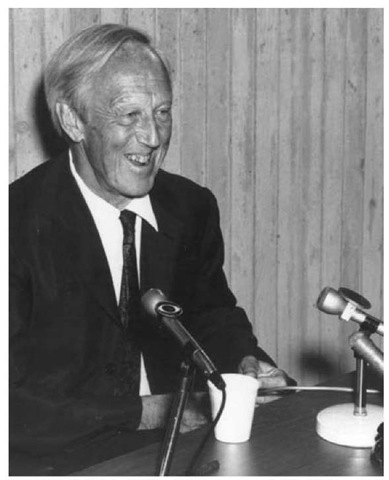Although Hannes Alfven’s name graces many physical phenomena that he identified—Alfven waves and the Alfven speed, Alfven layers, Alfven critical points, Alfven radii, and Alfven distances—his actual role in the advancement of astrophysics has been obscured by the belated acceptance accorded many of his discoveries. He received the 1970 Nobel Prize for "his contributions and fundamental discoveries in magneto-hydrodynamics, and their fruitful applications to different areas of plasma physics." Early in his career, he theorized that plasma, or highly ionized gases, filled interstellar space (instead of a vacuum, as was then believed), an assertion that created much controversy until sophisticated experimentation proved him right. Alfven attributed this dynamic to the politics of science, which ironically resist the overturning of the status quo (despite the fact that science bases itself on the notion of objectivity and the notion of progress).
Hannes Alfven was the first space scientist to be awarded the Nobel Prize.
Hannes Olof Gosta Alfven was born on May 30, 1908, in Norrkoping, Sweden. His mother, Anna-Clara Romanus, was one of the first female physicians in Sweden, and his father, Johannes Alfven, was also a doctor. Two early experiences inspired his later interest in astrophysics and wave theories: the gift of an astronomy book by Camille Flammarion; and his building of a radio receiver as a member of his high school radio club. He studied mathematics and experimental and theoretical physics at the University of Uppsala, writing his doctoral dissertation on "Ultra-Short Electromagnetic Waves"—which combined his two childhood interests. The university granted 26-year-old Alfven his Ph.D. in 1934 and retained him as a docent in physics (as did the Nobel Institute for Physics in Stockholm).
The year before, Alfven had published the genesis of his theory on the origin of cosmic radiation in Nature. In it, he noted the insufficiency of contemporary cosmic ray theories, which did not "seem to be in accordance with the latest experimental results," instead insisting on the necessity of explaining "the origin of the cosmic rays, introducing no new hypotheses, and only applying the kinetic gas theory to the conditions of world space." In 1937, his proposal of a galactic magnetic field met with widespread resistance (if not scorn), as it directly contradicted the prevailing wisdom that a vacuum filled interstellar space. As with much of his work, it took several decades before experiments verified his theories, and by then, his name had often been forgotten in conjunction with the discovery. In this case, the study of cosmic magnetism is now an accepted discipline within astrophysics.
In 1939, Alfven submitted a paper explaining magnetic storms and the auroras to the Journal of Geophysical Research, which rejected it because it flew in the face of accepted theories propounded by Sydney Chapman, Alfven’s scientific nemesis, in favor of a return to the previously accepted theories of Kristian Birkeland. Chapman’s theories gained predominance due to their mathematical elegance, but satellite measurements in 1974 proved Alfven and Birkeland correct.
In 1940, the Royal Institute of Technology in Stockholm appointed 32-year-old Alfven professor of electromagnetic theory and electric measurements, which he considered a greater honor than his later Nobel Prize. Two years later, he published a succinct paper, "Existence of Electromagnetic-Hydrodynamic Waves" in Nature. Although this theory of electromagnetic wave propagation through plasma was not immediately adapted upon its publication, six years later, Alfven waves gained almost instant acceptance when the renowned physicist enrico fermi nodded in agreement ("Of course," he reputedly commented) at Alfven’s presentation of the theory in a lecture to the University of Chicago; "the next day, every physicist said, ‘of course,’" according to Alfven.
In 1946, Alfven changed titles to professor of electronics, indicative of a change in his research focus. In 1950, he published Cosmical Electrodynamics, a book that introduced many of his theories to the scientific community for the first time, as so many international scientific journals shied away from publishing his controversial ideas, relegating them to more obscure journals, often those published only in Swedish. In 1963, the Royal Institute created a chair of plasma physics for him.
In 1967, Alfven joined the University of California at San Diego as a professor of electrical engineering, a position that he split with his Royal Institute post, crossing the Atlantic each equinox. That year, the Royal Astronomical Society granted him its Gold Medal, and three years later, he shared the 1970 Nobel Prize in physics with French physicist Louis Neel. The next year, he received both the 1971 Gold Medal of the Franklin Institute and the Lomonosov Medal of the U.S.S.R. Academy of Sciences.
In 1990, the Royal Institute established the Alfven Laboratory in his honor, and the next year, he retired. Alfven died at his home in Djurs-holm, Sweden, on April 2, 1995.

